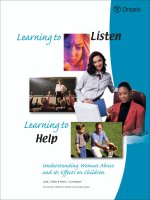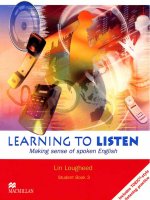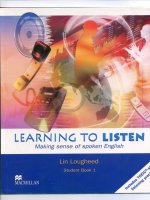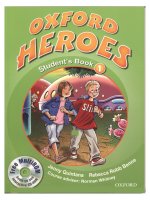Learning to listen student book 1 full plus CDs
Bạn đang xem bản rút gọn của tài liệu. Xem và tải ngay bản đầy đủ của tài liệu tại đây (22.01 MB, 76 trang )
LEA
I
G
I
Making sense of spoken English
Lin Lougheed
Student Book 1
�
MACMILLAN
Macmillan Education
Between Towns Road, Oxford
OX4 31'1'
A division of Macmillan Publishers Limited
Companies and representatives throughout the world
ISBN-13: 978 0 333 98885 5
Text © Lin Lougheed 2003
Design and illustration © Macmillan Publishers Limited 2003
First published 2003
All rights reserved; no part of this publication may be
reproduced, stored in a retrieval system, transmitted in any
form, or by any means, electronic, mechanical, photocopying,
recording, or otherwise, without the prior written permission
of the publishers.
Illustrated by Kevin Hopgood, Louise Morgan, Val Saunders and
Jane Smith
Cover design by Xen Media Ltd
Cover illustration by Coneyl Jay
The publishers would like to thank Hiroshi Asano, Stuart Bowie,
James Boyd, Anthony Brewer, David Brooks, Steven R. Brownell,
Sylvia Chao, Frank Claypool, Elizabeth E. Colford, Peter Collins,
Sheelagh Conway, Ann Cunningham, Janet Denny, Joseph Dias,
Gary Farmer, Clyde Fowle, Masaki Fujimoto, William Green,
Takashi Rata, Grace Hsu, Yukari Kanzaki, Yuko Kobayashi,
Jeong Sook Lee, Mallory Leece, Pearl Lin, Peter Littlewood,
Terry McKinnon, Steve Maginn, Richard Manuel, Charlene Mills,
Harumi Nakazawa, James Pagel, Tawatchai Pattarawongvisut,
John Perkins, Harumi Nakazawa, Rube Redfield, Cristina Roberts,
Terry Roberts, Elizabeth Root, Satoshi Saito, Yoshiharu Saito,
Maria Luiza Santos, Hajime Shishido, Elliot Taback, Tadakuni
Tajiri, Andrew Todd, Kris Vicca, Genet Falconeri Watanabe,
David Wade, Robert Weschler, Sandra Wu
T he authors and publishers would like to thank the following for
permission to reproduce their photographs: Alamy/H. Delespinasse
p21(a), S.Sarkis p43(4); Corbis/L.Kennedy p21(d), W.Hodges
p24(1),S.Dorantes p69(2), C.Savage p73(2); Corbis Royalty Free
Images p53; Eye Ubiquitous/A.Amsel p23(2), P.Scheult p51(1);
GettyN.C.L p10(b), Yellow Dog Production pll(2), A.Marsland
p19(1), D.de Lossy p19(2), Color Day Production p21(b), D.Bremner
21(c), D.Bosler p24(4), A.Nagelmann p29(1), D.Harriman p29(2),
L.D.Gordon p32(2), R.McVay p32(4), C.Bissel p37(1), G.Buss p37(2),
R.Lockyer p39, T.Hopewell p41(2), F.Herholdt p46, L.Santow p51(2),
N.White p55(1), J.Gray p55(2), M.Romanelli p65(1), A.Moller p65(2),
Yellow Dog Production p69(1), S.Rowell p73(1); Robert
Harding/J.Thomas p10(d), W.Rawlings p47(2); ImageState pp 10(c),
24(2), 24(3), 27, 33(1), 41(1), 43(2), 47(1); Macmillan Archive p53;
Panos Pictures/S.Sprague -p23(1), J.Holmes p32(1); Photodisc p32(3);
Powerstock pp10(a), 11(1), 33(2)
Commissioned photographs by Haddon Davies p53 (salad and pasta)
Printed and bound in T hailand
2010
13
2009
12
11
2008
10
9
2007
8
Contents
Scope and Sequence
4
Introduction to the Student
6
Introduction to the Teacher
7
1 First Day
8
2 All About You
12
3 At the Internet Cafe
16
4 Let's Go
20
Review 1
24
5 What Time Is It?
26
6 Describing Yourself
30
7 How Will I Know You?
34
8 What's on TV?
38
Review 2
9 Planning Your Day
42
44
10 Free Time
48
11 Let's Eat
52
12 At Home
56
Review 3
60
13 Sunny or Cloudy?
62
14 On the Block
66
15 Downtown
70
16 Let's Celebrate
74
Review 4
78
Scope and Sequence
Unit
1
2
First Day
All About You
Topi-c
Skills
Registering for class
Identifying first and family names
Introducing yourself
Distinguishing between formal and
Nicknames
informal tones
Data forms
Identifying personal information
Distinguishing e-mail and Internet
symbols
3
At the Internet Cafe
Break activities
Identifying actions and prices
Internet Cafe
Distinguishing between amounts
Computers
4
Let's Go
Transportation
Identifying travel and transportation
information
Distinguishing between different
pronunciations
Review 1
5
What Time Is It?
Talking about time
Identifying time and appointments
Changing schedules
Distinguishing between dates and times
Dates
6
7
Describing Yourself
Describing yourself
Identifying characteristics and habits
Giving physical
Distinguishing between difficult
descriptions
pronunciations
How Will I Know You? Identifying people
Talking about clothes
Identifying physical descriptions and
locations
Distinguishing between /1/ and /r/
8
What's on TV?
Watching TV
Identifying different types of TV program
Distinguishing question and statement
intonation
Review 2
4
Unit
9
Planning Your Day
Topic
Skills
Daily activities
Identifying pastimes and schedules
Planning your day
Distinguishing between different word
.
stress
10
Free Time
Hobbies and other
leisure activities
Identifying likes and dislikes
0
0
�
0
...
hinQ tht nlclmB@f of �Yllllblu�
in a word
11
Let's Eat
Discussing food and
Identifying preferences for food
meals
Identifying between negative and
affirmative statements
12
At Home
Describing your home
Identifying location in the home
Furniture
Distinguishing between the prepositions
on and in
Review 3
13
Sunny or Cloudy?
Weather
Identifying weather and statistics
Clothing
Distinguishing between different ways of
expressing the weather
14
On the Block
Discussing activities and Identifying everyday activities and
amenities on your block
location in town
Talking about urban
Distinguishing unstressed words in a
settings
sentence
Talking about services
in town
15
Downtown
Downtown businesses
Identifying directions and location
Locations of landmarks
Distinguishing between tenses
Directions
16 Let's Celebrate
Celebrating holidays
Identifying holiday events
Family traditions
Distinguishing between bored and
enthusiastic attitudes
Review 4
5
Introduction to the Student
This series will help you become more confident about the
listening you do both inside and outside the classroom.
With these books you will:
•
learn to listen appropriately
•
learn to understand correctly
•
learn to make more sense of what you hear.
You will hear a variety of sources such as conversations,
messages, radio broadcasts, and other forms of real English,
and you will learn to listen both for detail and for the general
meamng.
As students you want to feel confident in real-life situations
when you are speaking E nglish. Through this series you will·
hear what real E nglish speakers say in everyday situations,
such as meeting strangers or planning a celebration, and
learn to understand the words they use.
This series prepares you to react appropriately to the people
you m eet by helping you to make sense of the meaning behind
the words they use. You will learn about the influences of a
speaker's mood, location, and b ackground on the language she
or he uses.
You will gain confidence in listening and responding to
everyday situations in E nglish. You'll be able to react to the
personalities of the people you meet, understand the words
they use, and make sense of what you hear.
6
Introduction to the Teacher
This three-book listening series helps make every minute of
the classroom experience as rich as the real world. The topics,
the activities, the personalities, the beliefs, and the accents
reflect the variety in the world around us. In the series,
students meet different people, discuss different things, have
different attitudes, and have different reactions.
To m ake the listening experience as authentic as possible, the
series presents listening challenges from a variety of sources:
dialogs, recorded messages, monologues, radio broadcasts,
reviews, p ublic service announcements, and weather
announcements.
In these books students tackle real-world tasks that prepare
the m for the kind of listening they will do outside the
classroom : listening for different purposes, making inferences,
personalizing the experience, and m aking assumptions and
predictions.
Students need to b e actively involved in the process of
learning to listen and listening to learn, because this m akes
learning much more effective. This is achieved by asking them
to listen for a purpose, read the clues about speakers' mood,
intention and b ackground, and making students aware of the
process they use in their own native language to make
linguistic input comprehensible.
Students wish to react and express themselves appropriately
in real-life situations. For that reason, all three books show
how people react and cope in everyday situations - and they
do so in a way that sh.ows their personality, character, and
attitude. By listening to, observing, and judging people in
these contexts , students will learn that they too are able to
express their p ersonality when they speak E nglish- a m ajor
step in becoming proficient in E nglish.
7
First Day
1
What's going on?
These students are registering by last name for a class.
Check (V') the column they should be in.
1. Kevin Tang
2. Dallas Hillwood
3. Cindy White
4. Mai Linh
5. Betty Sanchez
6. David Crandall
2
A-H
1-R
8-Z
D
D
D
D
D
D
D
D
D
D
D
D
D
D
D
D
D
D
Who's who?
Listen and check (V') the correct name.
1.
2.
8
D
D
D
D
Jessica Noh
3.
Jessica Knowe
Kevin Dang
Kevin Tang
4.
D
D
D
D
Lane Morgan
Morgan Lane
Carol Drexter
Carl Dexter
3
Checking name s
Listen and check (V") who is in the class today. Then listen
again and correct the spelling of their names.
In class
./
Correction
Name
Hi rok.o
Hiroki Aoki
Aok.i
Hillwood Dallas
Lee Toon
Linh Mai
Picot Cora
Sandor Silvas
.
4
Who are you?
Listen and complete the cards with people's names.
Conversation 1
'
Conversation 3
'
\
'
�
'
�
4-
�
Conversation 4
Conversation 2
4
\
'
\
�
'
\
9
5
What's your nickname?
Listen and match the names with the correct nicknames.
6
Sandor
Betty
Dallas
Cindy
Cynthia
Sunny
Elizabeth
Big D
Train your ear
Listen to the four conversations and number the pictures.
a.
c.
b.
d.
Listen to the conversations again. Is the language formal or
informal? Check (.!) the right column.
formal
1.0
2. D
10
informal
D
D
formal
3.
4.
D
D
informal
D
D
7
Test yourself
Listen and circle the answer that matches the picture.
1. (A) (B) (C)
2. (A) (B) (C)
Listen and circle the best response.
3. (A) (B) (C)
�
4. (A) (B) (C)
Listen to the conversation and to the question that follows.
Circle the best answers.
5. (A) Mark and Lee.
8
6. (A) Bob.
(B) Lee and Wong.
(B) Sleepy.
(C) Mark and Wong.
(C) Red.
Your turn
Speak to three people and complete the chart below with
their information. Use: What's yo ur fi rst/last name? How do
you spell it? What's you r n ickname?
..
Pe.r�ol\ 2
Fir�t
�
Pe.r�ol\ .3
MMe.
------
Nick.M.Me.
11
All About You
Full Name
____
(1)
____
FIRST NAME
Mark
Mr.
(3)
3498
-----
P.
West
(2)
LAST NAME
Grand
Canton
Drive
Detroit
State/Province I Zip Code
____
____
Telephone
1
48 2 o 1
MI
(4) USA
(5)
m
_
313-554-7 645
What's going on?
The teacher is writing personal information on the board.
Complete the form with the words in the box.
�
2
E-mail Address
Country
Middle Initial
Title
Address
Occupation
Who's the teacher talking to?
Listen and circle the correct title. Then listen again and
check (V") what is discussed.
Title
Last Name
1. Mr./Mrs.
Brown
2. Ms./Mr.
Dart
3. Mr./Ms.
Lima
4. Mrs./Mr.
12
Occupation
Address
Fernandes
--
5. Ms./Mr.
First Name
King
-
Address
Zip Code
Where do you I ive?
Listen and correct the written information. See the example.
1.
2.
3.
Name:
John Spenver
Address:
9-4-06 Ma5on L-ane
Name:
fe_te.r
TrcM\
1\ive.rside.. Drive.
Address:
17:51
Name:
HC..r-r-y R�;on
Address: 5' oow
4.
5.
Narne:
Jo'?e...ph �e...rr\ar\de...'?
Address:
_4-b
&re...e...rl
'5-t.
Name:
AI.Con Roc..d
Where are you from?
Listen and put B next to the country where people were born
and V next to the country they are visiting.
Then listen again and write how long they have visited for.
See the example.
1. Van Lee
'furkey
England
Vietnam
V
I
we.e.k
�
5. Roberto Carrera
2. Fen Wu
United States
4. Joseph Peres
Argentina
Brazil
Japan
_
___
Mexico
China
Hong Kong
Japan
Spain
3. Marc Tirard
Italy
Korea
France
13
Train your ear
Even symbols have sounds. These are some common symbols
found in e-mail and on the Internet.
@
•
-
means
at
means underscore
means dot
/
•
•
means
hyphen
means forward slash
means colon
Listen to the e-mail and Internet addresses. Write the symbols
you hear. See the example.
@
1.
6
•
4.
_
_
_
2.
__
_
5.
__
_
3.
__
_
6.
__
_
E-mail or telephone?
Listen and check (V') how people like to be contacted. Then
listen again and correct the wrong information.
1.
•••••••
••••••••
ma
Alfred Li
0
0
E-mail:
Telephone:
net.bz
lima@yupi.
340
(55 071) 345-3
•••••••
••••••••
Joseph Wu
0 E-mail:
0 Telephone: [886 02) 369-7556
4.
2.
Dallas Hill
wood
0
E-mail: dallas-hill
wood@n
0
14
3.
aa.com
Telephone: (J 71
4) 330-4893
r
�tiC
........ 'J\It)ttyen
�
0
E-mail:
0
••••••••
xm.fpt.vn
nguyen-duc@h
Telephone:
21
(84 04) 657-33
7
Test yourself
Listen and circle the answer that matches the picture.
2. (A) (B) (C)
1. (A) (B) (C)
Listen and circle the best response.
4. (A) (B) (C)
3. (A) (B) (C)
Listen to the conversation and to the question that follows.
Circle the best answer.
5. (A) Her title.
6. (A) Reading e-mails.
(B) Her husband's name.
(B) Writing letters.
(C) Her correct address.
(C) Talking on the phone.
Your turn
Complete your own personal information form.
Full Name:
Full Name:
TITLE
FIRST NAME
MIDDLE INITIAL
LAST NAME
TITLE
FIRST NAME
Address:
Address:
City:
City:
State/Province I Zip Code:
State/Province I Zip Code:
Country:
Country:
E-mail Address:
E-mail Address:
Teleph�e:
Telephone:
MIDDLE INITIAL
LAST NAME
Ask your partner for information from her/his form.
Use: What's you r . . . ? What's your phone num ber?
15
At the Internet Cafe
1
What's going on?
Look at the picture and complete the sentences. Use: talking,
w a i ting, checking, ordering, reading.
1. Two people are
their e-mail.
the newspaper.
2. One man at a table is
3. A customer is
4. Several people are
5. One woman at a table is
2
coffee.
in line.
to her friends.
H ow much?
Listen and circle the price you hear.
1. Two bottles of water cost $2 I $4.
2. With $3 I $4, you can buy water and a cup of coffee.
3. A sandwich and a cup of coffee cost $6 I $7.
4. I only have $1 I $2. I'll have a cup of tea.
5. I'll have coffee, a sandwich and a piece of cake. That's $9 I $10.
6. We'll have two pieces of pie and two cups of tea. Here's $8 I $10.
16
Train your ear
Numbers 13- 19 have a different stress from numbers 30, 40, 50, etc.
Listen to the examples:
•
•
thirteen
The stress is on the second syllable.
thirty
The stress is on the first syllable.
•
•
Listen and circle the numbers you hear.
4
1. a. 100 I 120 million gallons
2. a. 150 I 115 cups
b. 16 I 60 million gallons
b. 40 I 14 cups
c. 19 I 90 million gallons
c. 13 I 30 bottles
Who's taking a b reak?
Listen and number the pictures. Then listen again and circle
the correct number of minutes.
a.
c.
10
15
20
30
minutes
10
15
20
30
minutes
10
15
20
30
minutes
10
15
20
30
minutes
b.
17
5
H ow much?
Listen and write the missing numbers.
Internet cafe
Large
Small
$3
$ (2a)
Coffee
Tea
Soft Drinks
Bottled UJater
or
or
$ (1)
$3.50
$2
$ (2b)
a minute
Computer Time (3)
Uoice-Ouer-1 nternet
a minute
(4)
Pay up
Listen and number the receipts. Then listen again and
complete the missing numbers.
a. Receipt
6
min
c. Receipt
__
Voice-Over-Internet
1
__
coffee
$4.00
$4.00
@.50
$3.00
TOTAL
TOTAL
$3.00
Amount
$
Change
Amount
Paid
_
Paid
$
__
$
__
$
Change
_
...___.,.��
b. Receipt
d. Receipt
__
1
bottled water
1
small
tea
TOTAL
Amount
Change
�
18
Paid
$2.00
10
__
min Computer
time
$2.00
@.30
$3.00
$4.00
TOTAL
$3.00
$
Amount
__
$_
Change
Paid
$
_
$_
���
7
Test yourself
Listen and circle the answer that matches the picture.
1. (A) (B) (C)
2. (A) (B) (C)
Listen and circle the best response.
3. (A) (B) (C)
4. (A) (B) (C)
Listen to the conversation and to the question that follows.
Circle the best answer.
5. (A) Pay more than $5.
6. (A) Coffee and bottled water.
(B) Check his e-mail.
(B) Coffee and a soft drink.
(C) Buy a computer.
(C) Just coffee.
Your turn
Complete the chart, then ask two people for their
information. Use: Do you use e-ma i l ? Do you check it a t
work or a t home? What's your e-m a i l address?
..
t-MA.il
Yow- A.�r
Per$ot.. I
Per$ot.. 2
LA$e.
C�a:.
..
AddrU$
19
Let's Go
1
What's going on?
Write these words in the correct categories.
car
airport
rider on foot
bike
fly
plane
get off
take
People
2
drive
boat
motorbike
passenger
get in
park
visitor
Transportation
Listen and number the boxes.
b.
c.
20
D
D
D
bus
d.
bike
e.
car
f.
D
D
D
train station
train
bus
taxi
get out
tourist
H ow are you going?
a.
get on
on foot
taxi
train
Action
Location
3
What are you talking about?
Listen and number the pictures.
4
a.
c.
b.
d.
Are you going by train?
Listen and circle the correct phrase.
1. on foot I by bus
4. by train I by plane
2. by car I by bus
5. by boat I by bicycle
3. by bike I by car
6. by train I by bicycle
21
5
Train your ear
Sometimes it is hard to hear the difference between on and
off, or in and out. Listen to the example:
She's getting off the bus. She 's getting on the bus.
Listen and circle the correct word.
6
1. They're getting on I off the plane.
5. He's getting on I off the bus.
2. She's getting on I off the train.
6. He's getting in I out of the car.
3. He's getting on I off the plane.
7. They're getting on I off the train.
4. She's getting on I off the bus.
8. He's getting in I out of the car.
Now where?
Listen and number the pictures. Then listen again and write
the numbers for Track, Exit, Bus No. and Ga te.
a.
b.
d.
To GATE
+
22
71
Test yourself
Listen and circle the answer that matches the picture.
1. (A) (B) (C)
2. (A) (B) (C)
Listen and circle the best response.
3. (A) (B) (C)
4. (A) (B) (C)
Listen to the conversation and to the question that follows.
Circle the best answer.
5. (A) M-14.
6. (A) Riding a bike.
(B) M-40.
(B) Taking a walk.
(C) N-40.
(C) Riding in a car.
Your turn
Complete the chart, then ask three people for their
information. Use: How are you go ing . . . ?
...to��?
•..
ol\ v�c�tiol\?
23
Review 1
Check ov er yo ur ID
Listen and correct these
ID cards.
1.
Hsiao
Mr. Eddie
Address
2nd
Floor, No. 6 , Lane
Shuang Chen St.
42
3.
City
Taipei
.
State/Provmce I Zip Code
E-mail Address
Taiwan
Telephone
2 -596-2 1 34
Country
Occupation
Dr.
Bruno
Add ress
116
Ave nida
Preside
nte,
City
R.io de
Lawyer
430
Janeiro
State/Pro
vince I Z
ip Code
Coun try
OI03I0
7.ooo
Brazil
E -mail A
ddress
balvari
Tele pho
no_dial
ne
din.net
.b r
2
39-686
Occupati
7
on
2.
Studen
t
Witte
de W i
thstr
City
a at 4
5
S ta te/P
rovinc
e/ Zip
Coun t
Code
ry
3012
BR
Nethe
Addres
rland
s
s
Telep h
Pdm.da
one
m en @ n
yP .nl
Occup
020ation
411-0
l-24
Artis
t
4.
St. SW
.
State/Provmce I Zip Code
Country
E-mail Address
USA
DC 2 00 2 7 -1432
.
marla_c larke @errals.com
2 0 2 -555-2 3 2 3
Telephone
;: �-=�
ce Manager
�
�o
i�
:�
f�
f�
Occupati�n
��
------------
24
If]
Conversation review
Listen and circle the answer that matches the picture.
1. (A) (B) (C)
3. (A) (B) (C)
2. (A) (B) (C)
4. (A) (B) (C)
Listen and circle the best response.
5. (A) (B) (C)
6. (A) (B) (C)
7. (A) (B) (C)
8. (A) (B) (C)
Listen to the conversation and to the question that follows.
Circle the best answer.
9. (A) Buying a computer.
10. (A) 6:42
(B) Going to school.
(B) 4:42
(C) Checking their e-mail.
(C) 2:42
25









